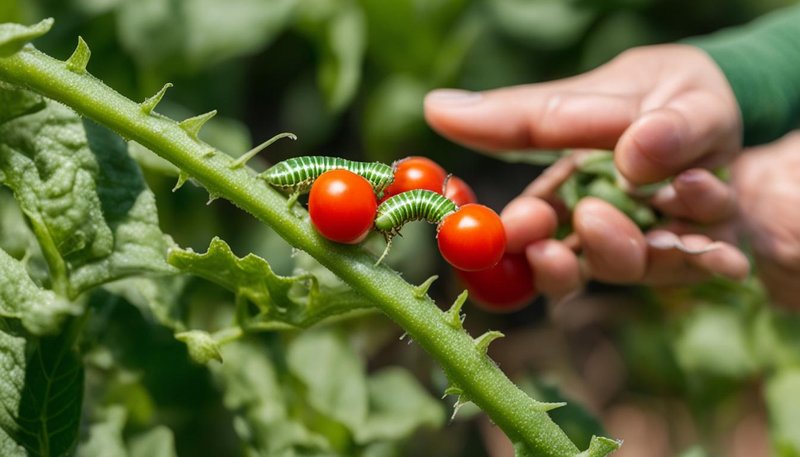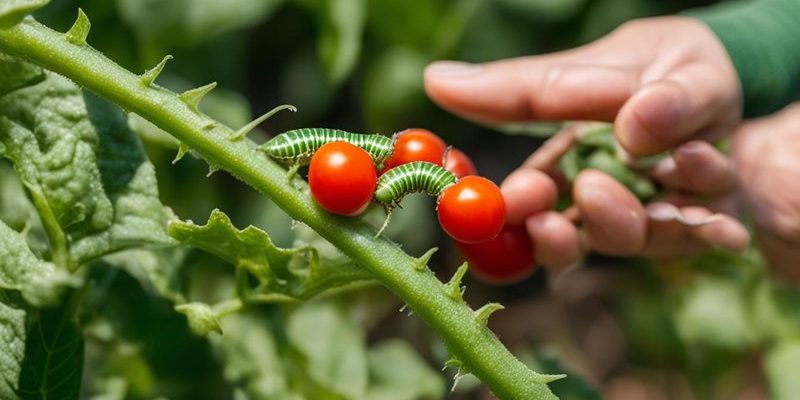
Think of hornworms like sneaky thieves. They creep in at night, chowing down on your plants while you sleep, and it’s up to you to catch them before they do big damage. Grab your gloves and a container, and let’s dive into the best methods of handpicking these little green intruders without harming your plants.
Understanding Hornworms
Hornworms are the larvae of hawk moths, and they can sometimes grow up to 4 inches long. They’re often green, making them blend perfectly with the leaves of your plants. Here’s the thing: While they can be destructive, they’re also a vital part of the ecosystem, helping to nourish birds and other creatures. So, it’s all about balance.
You might be wondering how to tell if you have hornworms in your garden. Often, you’ll notice *large* holes in the leaves or find droppings on the ground below your plants. Catching these pests early can save your plants from severe damage, so it’s good to keep your eyes peeled!
The Best Time to Handpick Hornworms
Timing is everything when it comes to handpicking hornworms. Ideally, you want to check your plants in the early morning or late evening. During the heat of the day, hornworms tend to hide and blend in with the foliage. However, as the sun rises or sets, they wander out to munch on leaves.
Think of these times as their “dining hours.” During your morning coffee or evening wind-down, take a stroll through your garden and look closely at the undersides of leaves. You might even find some of them asleep, making it easier to catch them without causing damage to your plants.
How to Handpick Hornworms Effectively
Now, let’s break down the actual process of handpicking hornworms. It’s easier than you might think! Here’s how to do it effectively:
- Gear Up: Put on gloves to protect your hands. This also helps you grab the worms securely without squishing them.
- Use a Container: Get a small container or bag to collect the hornworms. This keeps them contained while you’re working.
- Check Plants Carefully: Look under leaves and along the stems. Hornworms love to hide in spots that are hard to see.
- Be Gentle: When you find a hornworm, gently grasp it and remove it from the plant. Avoid yanking or pulling, as this could damage branches or leaves.
You might find yourself on a bit of a scavenger hunt. Just remember to enjoy the process—after all, you’re protecting your plants while getting some fresh air!
Disposing of Hornworms Safely
What do you do with hornworms once you’ve collected them? There are a few options, depending on your gardening philosophy:
- Relocate: If you have a nearby area that can handle a few hornworms (like an overgrown field), you might choose to relocate them. Just be sure they won’t return to your garden!
- Compost: If you’re okay with a natural method, you can add the collected hornworms to your compost pile. They’ll break down over time and contribute to the compost’s nutrient content.
- Bird Feed: If you have birds in your yard, consider leaving the hornworms in an area where they can be easily spotted. Birds will happily feast on these pests.
Choose a method that aligns with your gardening style and beliefs. After all, you want to maintain a healthy environment, even for those pesky critters!
Preventing Future Hornworm Infestations
So, you’ve successfully handpicked your hornworms, but how do you prevent them from coming back for seconds? Here are a few strategies:
- Plant Diversity: Introduce a mix of plants in your garden. This confuses pests and makes it less likely for hornworms to settle in.
- Natural Predators: Encourage birds, wasps, and other natural predators by providing nesting areas or bird feeders. They’ll help keep the hornworm population in check.
- Regular Inspections: Keep doing your garden checks. Catching hornworms early means less damage and more healthy plants.
If you can create a balanced ecosystem, your plants will thrive, and you may even end up with a beautiful wildlife-friendly garden!
Understanding the Life Cycle of Hornworms
Gaining insight into the life cycle of hornworms can help you strategize your gardening efforts. They go through several life stages—from eggs to caterpillars (what we see as hornworms), to pupae, and finally to adult moths.
Knowing this helps you recognize when to be on the lookout. If you see moths around your garden in the summer, it’s likely they’re laying eggs. Take action during this time to minimize future infestations. The more you understand these critters, the better you can protect your plants.
Handpicking hornworms without damaging your plants takes a little practice, but with the right approach, it can become a part of your gardening routine. By being vigilant, gentle, and proactive, you can keep your garden healthy and thriving.
Remember, you’re not just safeguarding your plants—you’re also engaging with nature as you learn more about the ecosystem around you. So, grab those gloves and containers, enjoy the fresh air, and keep your garden looking its best. Happy gardening!

